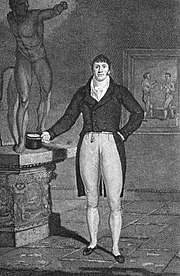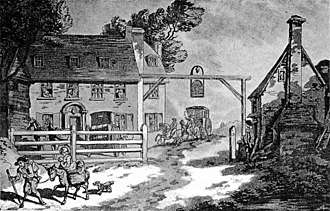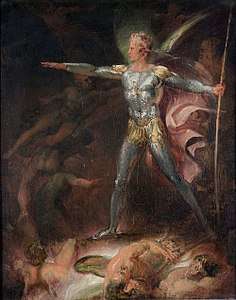John Jackson (English boxer)
John Jackson (28 September 1769 – 7 October 1845) was a celebrated English pugilist of the late 18th century. He became the 17th bare-knuckle boxing champion of all England on 15 April 1795, when he defeated Daniel Mendoza.
| John Jackson | |
|---|---|
 Jackson at 52, posing for artist, circa 1821 | |
| Statistics | |
| Nickname(s) | "Gentleman" John Jackson |
| Weight(s) | Heavyweight |
| Height | 5 ft 11 in (1.80 m) |
| Nationality | English |
| Born | 28 September 1769 Worcestershire County, or London, England |
| Died | 7 October 1845 (aged 76) Mayfair, London, England |
| Stance | Orthodox |
| Boxing record | |
| Total fights | 3 (professional, many amateur)[1] |
| Wins | 2 |
| Wins by KO | 1 |
| Losses | 1 |
Early life and boxing career, 1769-1795

John Jackson was born 28 September 1769 to a middle class Worcestershire family of builders who disapproved of his choice of boxing as a profession.[2]
In his boxing prime, Jackson stood 5'11" or 1.80 metres and weighed 14 stone or 195 lbs.[3] His symmetry in frame and muscular development made him a prized model for sculptors and painters. However, he was said to have a sloping forehead and ears that stuck straight out from the sides of his head.[1][2]
He was considered an exceptional amateur boxer prior to 1788. On 9 June 1788, aged around nineteen, Jackson defeated William Futrell at Smithham Bottom, England, in a bout lasting one hour, seven minutes.[1] Futrell was a giant of a man, undefeated, and held a string of 18 victories, when he faced the younger Jackson.[4]
In his second bout on 12 March 1789, against John Ingleston, on a rainy day at Ingatestone, England, he lost in five rounds, in a bout lasting twenty minutes and suffered a broken leg, not entirely uncommon during the brutal English bouts of the late 18th century. His injury was likely caused by a slip from the muddy ground. Many present believed Jackson would have won the bout if not for his unfortunate accident. Likely distressed by his injury, he announced his retirement after his loss, but would return six years later in his most important win.[2][1]
Boxing champion of England, 1795

Jackson won the championship of all England at age twenty-six in a fight on 15 April 1795, defeating the 16th all England champion Daniel Mendoza, the first English Jew to hold the title. The historic bout took place on a stage at Hornchurch in Essex. Heavyweight Jackson was five years younger, 4 inches (10 cm) taller, and 3 stone (42 lb; 19 kg) heavier than the middleweight Mendoza. The bout was only Jackson's third professional fight, but Mendoza's age, recent months in prison, and years of punishment in the ring gave the advantage to Jackson, the fresher and less battered combatant. Due to his lack of experience, Jackson was a 10-1 underdog in the betting.
The challenger won in nine rounds, paving the way to victory by muscling Mendoza into the corner of the ring, grabbing his hair, and pummeling his head with uppercuts using his free hand. Mendoza managed to come back up to scratch after this, but was soon knocked out. Jackson beat him into submission by the end of the 9th round. Mendoza asked for a foul for Jackson's hair-pulling, but it was ruled to be legal. Many other pugilists, such as James Figg and Jack Broughton, shaved their heads to avoid the possibility of this, until hair-pulling was eventually banned in boxing.[1] Mendoza's managers asked for a rematch, but Jackson refused and retired after his win the following year.[5]
Vacating the championship of England, 1796
In 1796, Jackson announced his retirement from the ring, officially vacating the boxing championship of England. His successor was shorter, lighter, Thomas Owen, who won the title on 14 November 1796 against William Hooper in a 40-round match in Harrow, England.[1]
Opening of boxing academy, 1803

With the recognition his new title brought, Jackson created a boxing academy for gentlemen at 13 Bond Street, in the West End of London, where he also resided, around 1803. Jackson is credited with a scientific style of boxing, which he taught at his academy three times a week during the London Season. His style was partly patterned after the revolutionary scientific boxing style of Daniel Mendoza, which was described in Mendoza's book, The Art of Boxing, published in 1789. It required adopting a posture of a slightly bent body, with head and shoulders forward, and knees slightly bent and at ease. Demonstrated above by Mendoza, the fists were held well up for defense in a position called the "guard". The left straight jab was used to keep an opponent at a distance and protect from an attack.[1] Jackson created rules in the fights he managed which included using fists alone, rather than scrapping with the entire body, and made hair holding and kicking illegal. Up to fifty rounds could be fought, however, and gloves, though available, were not used regularly until 1867. Most brutally, rounds were un-timed and ended only when one combatant was down.[6][2]
Jackson's academy was popular with the nobility and gentry and became a profitable business. His friend, the famed English poet George Gordon Byron, known as Lord Byron, an avid boxing fan, related in his diary that he regularly received instruction in boxing from Jackson. Jackson also profited from providing exhibitions for English and foreign lords and celebrities. Included among those for whom he arranged exhibitions were the Emperor of Russia, the King of Prussia, the Prince of Wales, and the Prince of Mecklenburg. Jackson's introduction of the sport to English and European royalty, made boxing a more admired and to some extent accepted sport in England.[2] Jackson was charitable and held benefits for numerous charities, once raising £114 for a Portuguese town destroyed by the French, and later £132 for the benefit of British prisoners in France.[3]
Opening the "Pugilistic Club", 1814
In 1814, he helped to establish an organization similar to the modern Boxing Commission. First formed at the Thatched House Tavern, the "Pugilistic Club", collected subscriptions from wealthy patrons and sponsored fights several times a year.[7] For each fight, a Banker was appointed to hold the purse as well as many side bets that might be made. Jackson was often nominated to be Banker. As a result of his work with the "Pugilistic Club" arranging fights, he is credited with helping to keep the sport honest in a time when bouts were often fixed.[8][2]

Jackson lived in comfort after his boxing career and worked as the proprietor of the Cock Hotel, a coaching inn in Sutton on the London to Brighton turnpike road. The inn served the needs of travellers, for food, drink, and rest, and was also a resting stop for those travelling by coach.[10] The London to Brighton stagecoach began in 1760, and the Cock Hotel was the 9am stop for coaches leaving the city.

In 1821, Jackson was asked to supply a force of unarmed men to preserve order at [3] King George IV's Coronation, where he also served as a page. With his boxing connections, he selected 18 prizefighters to protect the King, and to keep back those unauthorized to attend.[1][3]
Death in 1845
When Jackson died, on 7 October 1845, at his home at 4 Lower Grosvenor St. West, in the Mayfair district of London, he was said to be holding the hand of his beloved niece and adopted daughter, Elizabeth. His remains were interred in Brompton Cemetery, London.[11] He was honoured with a monument with a carved lion on his tomb costing upwards of £400 which was provided by his many friends and admirers.[3]
In recognition of his boxing skills, he was inducted into the Ring Boxing Hall of Fame in 1954 and the International Boxing Hall of Fame in 1992.[1]
Byron referred to Jackson as the "Emperor of Pugilism", and the leading prizefight reporter, Pierce Egan, writing in Boxiana declared him to be the "fixed star" of the "Pugilistic Hemisphere".[12]
In popular culture

In the artist Sir Thomas Lawrence's 1797 exhibition at the Royal Academy, an enormous painting of Satan Summoning His Legions, was based upon a giant portrait of the muscular Jackson.
Jackson features as a character in Rodney Stone, a Gothic mystery and boxing novel by Sir Arthur Conan Doyle.
He and/or his boxing academy are frequently mentioned in Georgette Heyer's Regency romances.
The characters of boxing opponents Jackson and Daniel Mendoza have minor but important roles in the 1942 British film The Young Mr. Pitt.
In August 2020 Jackson was featured in the BBC Radio 4 programme The Long View, in which he was compared to modern day footballer Marcus Rashford.[13]
| Achievements | ||
|---|---|---|
| Preceded by Daniel Mendoza |
All England Bare-knuckle Boxing Champion 15 April 1795 –14 Nov 1796 |
Succeeded by Thomas Owen |
References
- "John Jackson". Cyber Boxing Zone. Retrieved 7 September 2016.
- "The Old One-Two: Boxing in Regency England, by Regina Scott". Retrieved 7 July 2019.
- James, Ed. (c1879) The lives and battles of the champions of England from the year 1700 to the present time, New York.
- "Gentleman John Jackson".
- Defeated by John Jackson in The Jewish Boxer's Hall of Fame, Blady, Ken, (1988) Shapolsky Publishers, Inc., New York, NY, pps. 13-14.
- "Gentleman John Jackson and His Boxing Salon".
- "John Jackson". Gentleman's Sport in the Regency. Susana's Parlour. Retrieved 7 August 2019.
- Snowdon
- Sutton Council document
- Charles Harper (1922), The Brighton Road, Cecil Palmer, pp. 158–159
- "Archived copy". Archived from the original on 23 August 2006. Retrieved 11 April 2013.CS1 maint: archived copy as title (link)
- Snowdon, David, Writing the Prizefight: Pierce Egan's Boxiana World (Bern, 2013)
- https://www.bbc.co.uk/programmes/m000lf90